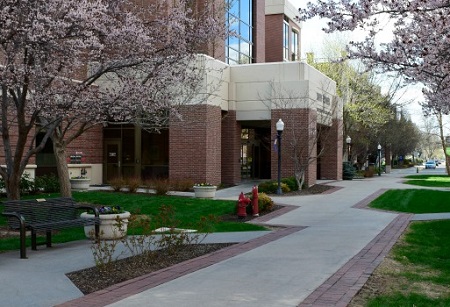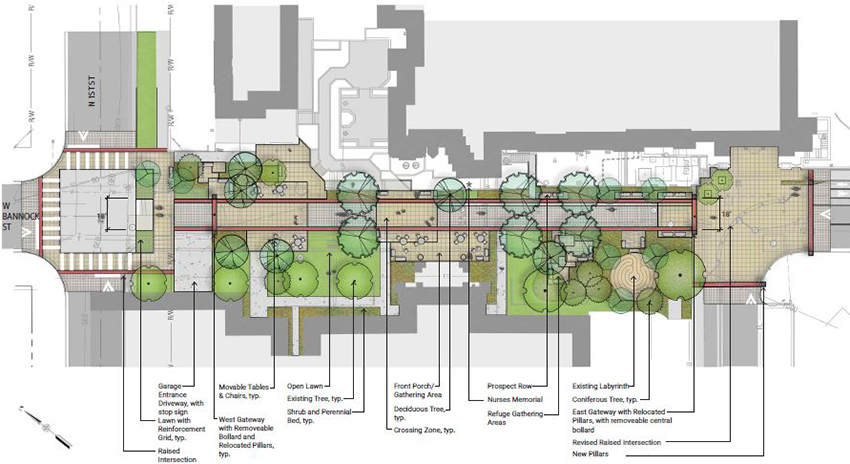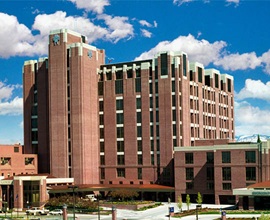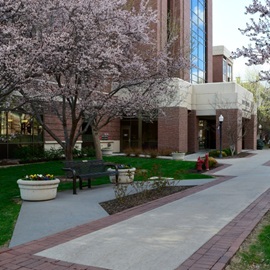Bannock corridor redesign moving forward

The plan for a major redesign of Bannock Street between Avenue B and 1st Street, which runs through the heart of St. Luke’s Boise Medical Center, is working its way through various city approvals.
The new design is at the request of the City of Boise, and is the result of numerous community workshops and planning sessions. It includes accommodations for all modes of transportation along with safe spaces for employees, patients and families who use this area as respite from the stress of the hospital.
The Boise City Council formally accepted the draft plan for the Bannock corridor in May 2017. The Boise City design review followed in June and St. Luke’s application request was approved with a few conditions. The city is now sorting out an appeal by the East End Neighborhood Association over the process by which the draft design was approved. The Design Review Committee approved the East End Neighborhood Associations appeal of plans to renovate the Bannock Street Plaza, in spite of a recommendation by Planning and Development’s staff to deny it because of the robust public workshop process and City Council approval of St. Luke’s Master Plan.
New design
The approved design of the Bannock corridor meets specifics outlined in the Memorandum of Understanding between St. Luke’s, the City of Boise and the Ada County Highway District (ACHD), and is part of the transportation infrastructure improvements to increase connectivity. It includes transportation amenities for pedestrians, cyclists and potentially cars (if Boise City Council later determines the need to open the area to vehicles and it is approved by ACHD). The design, which the council agreed to, provides that flexibility.
At 18 feet wide, a straight travel way on the north side would allow for two-way traffic to slowly pass through. The addition of bollards at each end would prevent vehicle access until the idea is studied and tested on a temporary basis. St. Luke’s agreed to allow the city to “study and test” cars on Bannock prior to the Jefferson closure to help inform the city’s decision. A trial period is particularly important as city and transportation planners evaluate safety, usage, bicycle speeds, potential conflict zones and nearby traffic patterns with the new roundabout, cycle track and improved intersections around the Boise hospital. The goal is for traffic and safety engineers to have the most complete understanding of how the new surrounding complex transportation infrastructure works together, including the Bannock corridor. Any final decision on cars remains several years out, and can’t happen before East Jefferson Street is closed and St. Luke’s grants the Bannock easement to the city.
The Bannock Street Plaza design also reflects the needs and desires of the St. Luke’s Boise Medical Center community. Aligning the travel way to the north allows for the creation of more open space and landscaped areas on the south side. St. Luke’s patients and families can seek privacy and solitude in more protected spaces, the community is welcome to stop and enjoy the area from one of the many benches and our employees will find areas to gather for lunch or an outdoor meeting.
Background on the Bannock corridor
As part of the comprehensive public process surrounding the St. Luke’s Downtown Master Plan, the health system agreed to preserve public access on Bannock between Avenue B and 1st Street, with an easement that was to include a multi-use path.
Following two years of community workshops, St. Luke's brought in one of the nation’s leading design and transportation consulting firms to lead conversations with diverse stakeholders to better understand various wants, needs, constraints, concerns and opportunities for the Bannock Street Plaza. The experts worked to find common ground for the ultimate design and use. The result was the initial design presented to and moved forward by Boise City Council.
“Throughout this process, St. Luke’s has been encouraged by council’s willingness to consider options that both balance its concerns and the desire expressed by some neighbors for open street access, with input from a wide range of community stakeholders,” said Chris Roth, chief operating officer for St. Luke’s Health System.

Next steps
St. Luke’s values every donation made to the Bannock Street Plaza. The design team has taken elaborate steps to inventory and document each donor brick, bench, plaque, light post, fountain and other special feature. The items will be safely preserved and stored in documented locations until the new space is ready. At that time, all efforts will be made to return the donations back to the St. Luke’s campus and ensure people know the new locations of donated items.
Once the city approval process is settled, St. Luke’s anticipates construction on the Bannock corridor will start in early spring of next year, and will provide more information about the schedule, design and construction plans as they’re finalized.
“St. Luke’s has worked hard to be a good neighbor throughout the last four years,” said Dave McFadyen, St. Luke’s Boise administrator. “By engaging with city leaders, planners, neighborhood groups, students, non-profits, cycling and pedestrian advocates, physicians and other interested groups, we have helped to craft a Bannock corridor design that balances a variety of diverse needs. In good faith, we’ve listened to community members, and met or exceeded the commitments we’ve made. St. Luke’s intends to do the same where Bannock is concerned.”
About The Author

Anita Kisseé was the Treasure Valley public relations manager for St. Luke’s Health System.


